Luc Van Lierde on lactate testing
Endurance Events and Lactate Testing
With Emphasis on the Triathlon
10 of 19
Lactate tests – Protocols and interpretation
Recreational Triathlete
These are triathletes who train 3 to 6 times a week for all 3 sports. The main objective of lactate testing for these athletes is not really to maximize the training effect (this would require much more training each week). It is to avoid mistakes or medically inappropriate exercise. The following table provides possible standard lactate tests (SLT) and control tests (CT) for running, swimming and cycling

To benefit from regular lactate testing using protocols of this type, the athlete in question must have been training for the triathlon or other distance events for 2-3 years and be able to complete an Olympic length triathlon in reasonable time. In other words the athletes should not be novices; they should be healthy, and care about their progress and performance. Anyone who is training only for fitness or social purposes is probably not a good candidate for lactate testing. The person's objectives may change over time so that lactate testing may become appropriate. But lactate testing is about optimizing conditioning to improve performance, not maximizing general fitness, weight loss, etc.
What If the Athlete is Much Better at One Discipline?
If the athlete comes from a history of one of the disciplines, then it might be necessary to perform a more demanding SLT in that discipline. For example, if the triathlete has been a competitive swimmer and still can swim well, then the SLT might be raised to 3 x 300m. Another consideration is that the SLT can be part of the training schedule. For example, a running set might be used as part of the running program for the day. As mentioned before, it is not profitable to do a test in swimming till the athlete has good stroke mechanics.
How Should the Test Be Executed?
Before testing each discipline, it is important to warm up for at least 15min at low intensity. In contrast to the triathletes at a higher performance level, the SLT tests can be done for the recreational triathlete whenever it is convenient. But tests for all three disciplines must not happen on the same day because recreational athletes are not at the fitness level that can handle this.
Sub-maximal: for each sport discipline, the lactate levels for the first step will usually be around 2 mmol/l. The second step should be between 2.5 and 4 mmol/l. If this is not the case, the recreational triathlete should retry after 10 min of a very easy regeneration effort. They should go slower if their lactate level is higher than 4 mmol/l or go faster if they have a lactate reading below 2.5 mmol/l. For a recreational athlete they should keep in mind the correction in intensity for the next time they do the SLT. It is better to err on the slow side the first time the test in done.
The objective of this is to determine the V4 level or the speed at which the effort generates 4 mmol/l of lactate. In cycling, this could be called the P4 for the power that generates 4 mmol/l of lactate. This is a general measure of the aerobic performance of an athlete in a specific discipline.
This value is only a reference to quantify the aerobic performance and not a magic intensity to train with. The results should be used to optimize the athlete's training program.
The objective of this is to determine the V4 level or the speed at which the effort generates 4 mmol/l of lactate. In tests done on a cycling ergometer, this could be called the P4 for the power that generates 4 mmol/l of lactate.
Whatever method athletes use to train, it can be evaluated by lactate testing. Here is a list of how one group of athletes develops their individual training programs. Such a list could be developed for triathletes and would probably be similar.
38% Heart Rates
28% Based on Feel
16% I Just do what I'm told by my coach
9% Based on lactate testing
8% There is only one intensity - 100%
The point is that no matter how you get and implement your training program, it can be evaluated by lactate testing. Obviously the only real test is how one does on race day but lactate testing and race performance usually coincide. That is what lactate testing is about: getting a good performance on race day because you will know that you are prepared.
It is possible to set training paces using the V4. However, we believe an athlete does not want to train near it. This is discussed more in the Assessing Performance Module.
One way to use lactate measurements to set training paces is to determine a baseline lactate for the athlete (usually between 1.3- 2.0 mmol/l) so that the coach and athlete know whether the athlete is training too fast or too slow. This might require 2-3 additional measurements beyond those needed to find a V4 level. It may not be necessary for the recreational triathlete, but the literature suggests that all athletes at all levels train harder than is best for their development. It is difficult to tell the athlete with a baseline of 2.2 mmol/l that he is training too hard if his lactate for a set is 2.5 mmol/. But this might be an appropriate interpretation if his baseline is 1.4 mmol/l.
Here is a running SLT for a recreational triathlete that measures the baseline as well as the V4. The initial running pace was 7:00 min for 1200 m, or quite slow. But this was the first time for the coach so it was a way to make sure the athlete could easily handle the test. Each 1200 m was increased 15 seconds till the athlete generated 4.6 mmol/l at 6:00. This test could be one of the two running workouts the athlete might do in the week. He covered 6 kilometers in this testing, which should be considered part of his training for the week. Next time the athlete could start at 6:30 and not have to complete each of these steps. Also after the last step the coach took two samples to make sure he recorded the highest lactate level from the step.
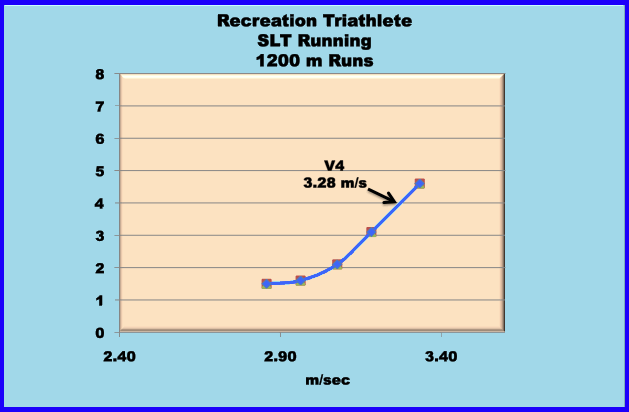
The coach or trainer should have a recording form that he or she uses during the testing. A simple form that we have seen used is the following.
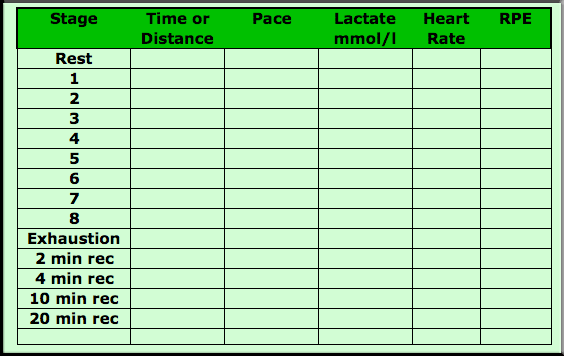
Here is the form for our recreational triathlete.
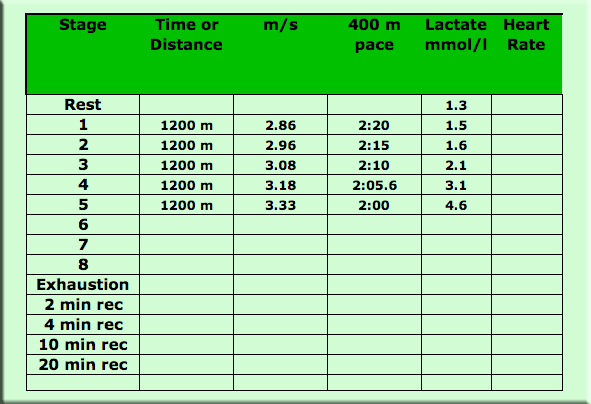
So what does this mean for this competitor? What does he do with the chart? First and most important, if the athlete had done a similar test previously, he will have a way to evaluate the training since that test and adjust it for the next cycle of training. Jan Olbrecht calls it “The Steering Principle”. You train, you test, and then you adjust the athlete's training based on what the testing shows. For this athlete the testing is simple and the objectives are simple: train to raise aerobic capacity which will generally be revealed in the test results if the V4 keeps moving to a higher pace.
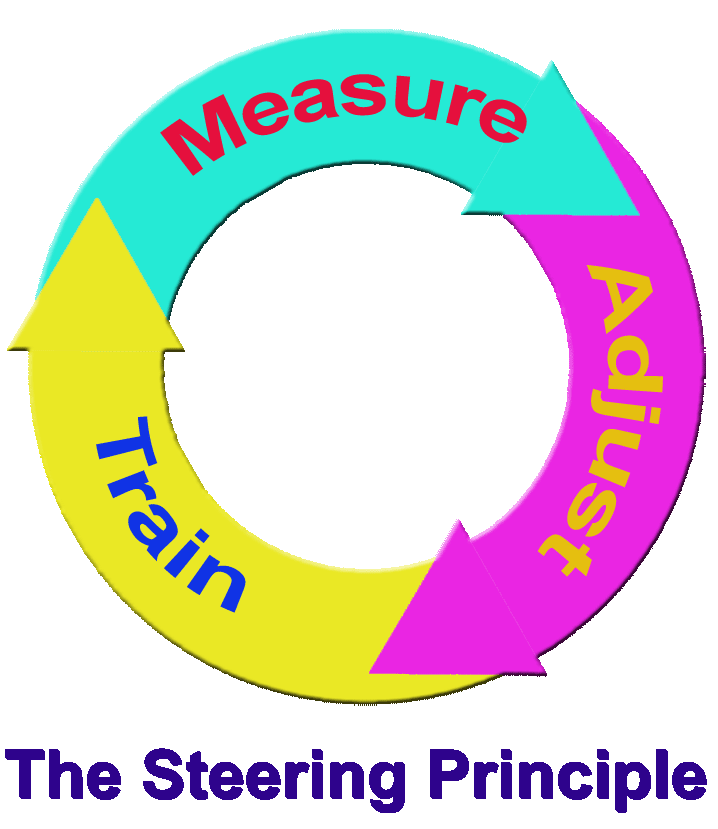
What if the V4 does not keep getting better. Then one of the main considerations is what sort of adjustments should be made. There are a thousand different training philosophies out there and not all of them can be right. Is this athlete using the optimal training program for him? Is he training too hard or too easy? Or is the proportion of each not best? Is there enough variety in the training sets? What the athlete over time is after is his own "best practices."
One thing we know is that this athlete has a long way to go before he does very well in a triathlon. But he may have limited near term objectives. Maybe he wants to break 3hr 30min in an Olympic length triathlon and to break 3 hours a year from now. Here is how he compares to other runners. He is the purple line over to the left.
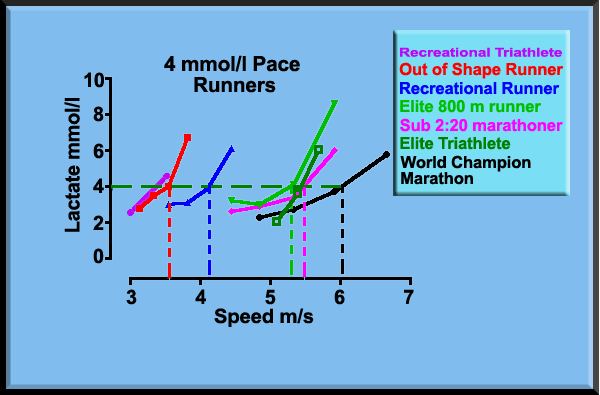
More examples of recreational triathletes - click for details
The Serious Competitor
A serious triathlete is defined as one who trains more than 6 times a week (including all 3 sports) and at least once every 48 hours. Within this group of triathletes, it is also useful to adjust training exercises and training intensities based on whether the athlete is aiming at an Olympic Triathlon (OT) or an Ironman (IM).
As the performance level of this group of athletes increases, it is important that much of the training volume be at a very easy intensity. The higher the performance level in competition, the higher the training volume. But for more elite athletes, more of their training should be at very easy intensities. We therefore stress the importance of very easy training sets: this is called regeneration training. Regeneration training has two objectives:
- Recovery
- Building up Aerobic Capacity
The training objective differs with the volume of the regeneration set. At low volume (max. 35 min) the regeneration training will stimulate the recovery of the athlete. At higher volume (more than 45 min) and following an intensive training unit within 24 hours, it will stimulate the improvement of aerobic capacity.
The following table provides a possible standard lactate test schematic (SLT) and control tests (CT) for running, swimming and cycling.

Lactate Testing Procedures for Serious Triathletes
Before testing: it is important to warm up for at least 20 min at low intensity. Ideally, SLT tests should all happen on the same day and in the same order as in competition but an athlete’s training plan and logistics may dictate a different schedule.
Blood sampling: as discussed above, the final test in each discipline needs at least 2 samples for the last sub-maximal test to be sure the highest post exercise lactate value is recorded. This is mandatory for the SLT and a short all-out effort in a CT. You can skip the second measure for the CT after a sub-maximal training set of at least 10 minutes. It is very useful to take a sample after the first and last repetition of a set to assess just what the set is inducing in terms of energy contribution between the two energy systems.
Sub-maximal: for the swimming test, a lactate between 2.5 and 4 mmol/l should be achieved for the second swim. If this is not the case, you should retry after 15min of very easy swimming. You should go slower if your lactate is higher than 4 mmol/l or go faster if you have a lactate reading below 2.5 mmol/l. You can count on about 4 seconds per 1 mmol/l lactate on a 400m swim. At this performance level the athlete should not skip this second attempt.
Again, the sub-maximal test can be designed to be part of the athlete’s training. One possibility is to use, for example, a 5 x 400m set at escalating speeds, with 1 minute rest in-between, and to take a blood sample after the first and last repetition.
Step tests: for running and cycling it is mandatory to have the first repetition around 2 mmol/l lactate and the last repetition above 4mmol/l lactate. If after the 3rd repetition the athlete does not surpass 4 mmol/l lactate, a 4th repetition should be added. If an athlete has done this type of test before, it will be relatively easy to gauge what is needed. However, frequently an athlete is new to the program and has not done lactate testing, so the coach must generate information on the athlete's conditioning level and potential for the first time. Also a coach may take more readings to get information on lactate readings at regenerative levels.
Different Levels of Serious Triathletes:
This classification includes nearly all triathletes who are competing in Ironman and half-Ironman events and in multiple Olympic length events. There is a wide range in this category. Some males in this category will finish an Ironman in under 9 hours while others will finish in 12-15 hours. While the testing will generally be similar for both ends of this spectrum, the training prescriptions will be quite different and it is important that the more developed in this group be looked at more carefully.
Here is an example of cycling tests for a female triathlete. First, the form for collecting the data during the test.
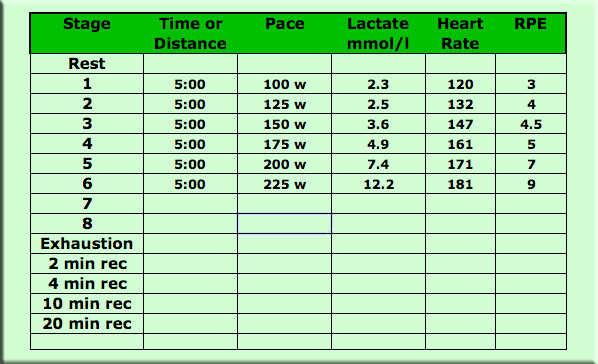
The form above was for one of a series of tests with this athlete. Here is the testing over a year. The testing on the chart below took place in March, August and March the following year.
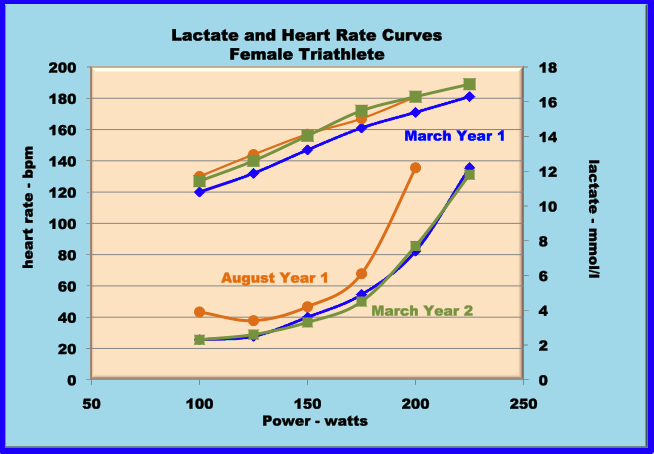
Notice a couple of things. The test in August (orange curve) was not nearly as good as the previous March (blue curve). The athlete had done well during the competitive season but was obviously very fatigued and was complaining that she was tired. She had lost substantial aerobic capacity. The prescription was mostly very low-level training before her next race in the hope she could regain some of the lost capacity. Also note that heart rates showed a mild deterioration but not to the extent lactate testing did. By the following March she was back to her previous conditioning level.
More Detailed Test
Some coaches want to estimate a Maximal Lactate Steady State for their athletes and to know in detail the lactate generated at all paces in order to be better able to prescribe appropriate training paces. In order to do this, the SLT must have several steps. This requires careful planning so as not to interfere with the athlete's training. Training always takes priority over testing. A popular model to estimate the threshold is the Modified D-Max method. This requires that the coach pinpoint the place where the lactate starts to rise and also demands that the athlete proceeds to exhaustion. This should only be done on the more advanced athletes. We are not convinced this is necessary, but many coaches prefer to do it. Here is an example of the Modified D-Max test used to evaluate a good swimmer. We show three separate charts for a good swimmer to illustrate the process.
.
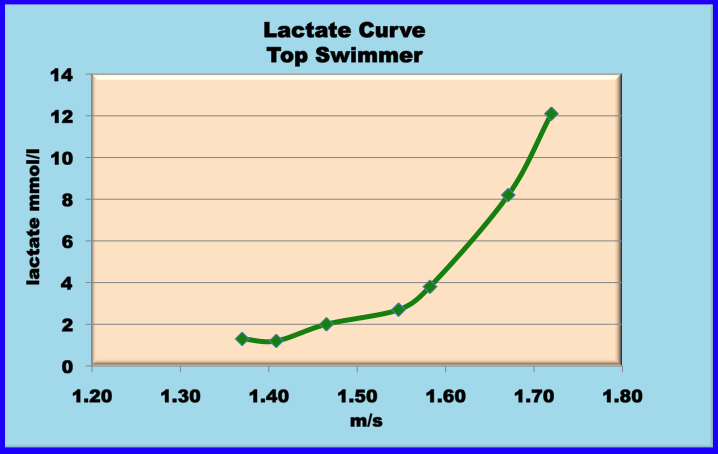
The test was done using 7 swims of 200m. Using 400m swims would have taken too long and be extremely tiring for the swimmer. Very often the curve is adjusted using a mathematical smoothing process to try to get at the real underlying biological process. Here is the same curve after it has been smoothed.
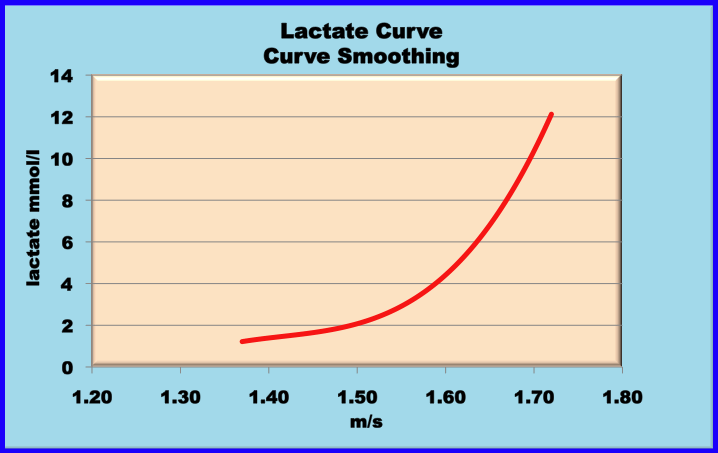
The Modified D-Max method requires that a line be drawn on the curve from the point where the lines starts to rise from the baseline to the end of the curve. The line is then moved such that it forms a tangent to the curve. The point where it touches the curve is considered the threshold.
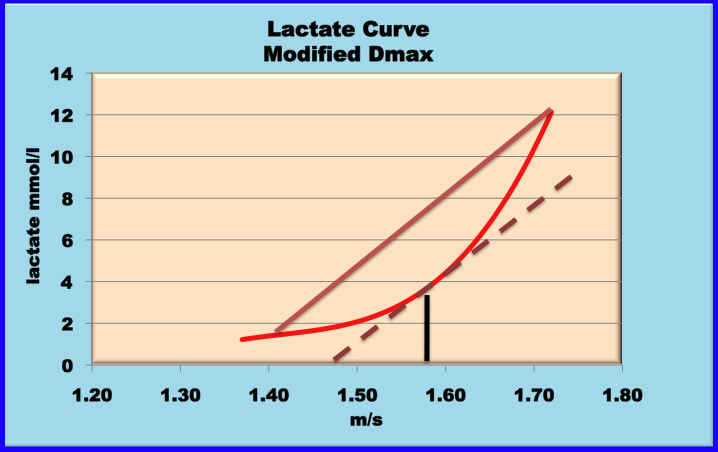
The point on the axis where the line from the tangent point meets the X axis is the estimate of the speed at threshold. Here it is about 1.58 m/s or about 2:06.7 for 200 meters. This is an elaborate process and probably should only be used if one has access to sophisticated computer programs. It is much simpler to calculate the V4 which is about 1.595 m/s or 2:05.4
We recommend that all who have gotten this far read the modules on Assessing Performance, Setting Training Paces, and the Anaerobic Mechanism. There you will find additional information that will help the coach to optimize the athlete's conditioning for the triathlon. These Modules apply to about 95% of those competing in triathlons and provide a framework for testing.
The Elite Competitor
The testing and training of the elite competitor is complex and cannot be described in a few paragraphs on a website. These athletes will finish in the top 20 at the Kona Ironman World Championships, and be in the top 100 of the ITU for the Olympic length triathlon. These athletes benefit the most from lactate testing, and the procedures are more exacting for them. Of course, highly elite athletes do the most training volume of anyone, but they do much of it at very easy paces (easy for them). This is because these athletes are most vulnerable to overtraining, and their very occasional intense paces are extremely fast.
Continue on to Module 11 which reviews what is useful in lactate testing.
Module 11 of 19 - a short review of what is useful in lactate testing
